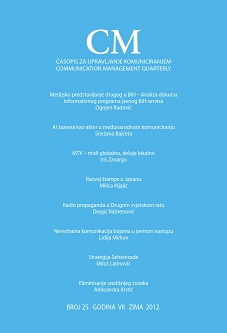Neverbalna komunikacija bojama u javnom nastupu
Non-Verbal Communication Through Colours in Public Appearances
Author(s): Lidija Ž. MirkovSubject(s): Politics and communication, Theory of Communication, Social psychology and group interaction, Cognitive Psychology
Published by: Fakultet političkih nauka Univerziteta u Beogradu
Keywords: non-verbal communication; public appearance; colours; rhetorics; chromatics;
Summary/Abstract: Journalists and their sources, this way or another, are indeed public speakers. We all take that role sometimes in our lives, whether we are aware of it or not and not only through the media. We speak publicly – without media or through media channels. The audience is reacting on words said, but even more on non-verbal communication: gestures, mimics, physical appearance of the speaker, environment, colours (of the clothes, walls or the package if it’s a product). In everyday life, we dress according to our mood, but when we are engaged in a public job, we can not afford ourselves that kind of luxury. Not only that the colours we choose affect the perception of others about our abilities to keep track with the latest fashion, but also there is a subconcious interpretation of the meaning for each colour in every human’s mind. When we see someone wearing pink, we consider he/she as friendlier than people wearing other colours. The person in red will be said to be tempered and active, but someone wearing grey will be considered to be passive and indetermined. The most important thing for a speaker (journalists, PRs, politicians and so on) is to be accepted by his/her audience. They shouldn’t forget to surround themselves with the colours that make the same or similar symbolic message which they express verbally in front of the audience. Well, at least it shouldn’t be the opposite. Several different perspectives on colours have emerged in science, but so far there were no researches about colours in public speaking. Chromatics exsists as a part of psychology, anthropology, the history of arts, theories of marketing and PR, but communication studies have just recently incorporated visual studies in European universities and from there spread on. Serbian authors also haven’t been trying to consolidate visual studies of chromatics into communication theories. They rather go with the flow of the traditional science which explors the subject. Hoping that one day visual studies and chromatics will become a part of Serbian academic community, this paper is about communication with colours during public appearances.
Journal: CM Komunikacija i mediji
- Issue Year: 7/2012
- Issue No: 25
- Page Range: 125-142
- Page Count: 18
- Language: Serbian

